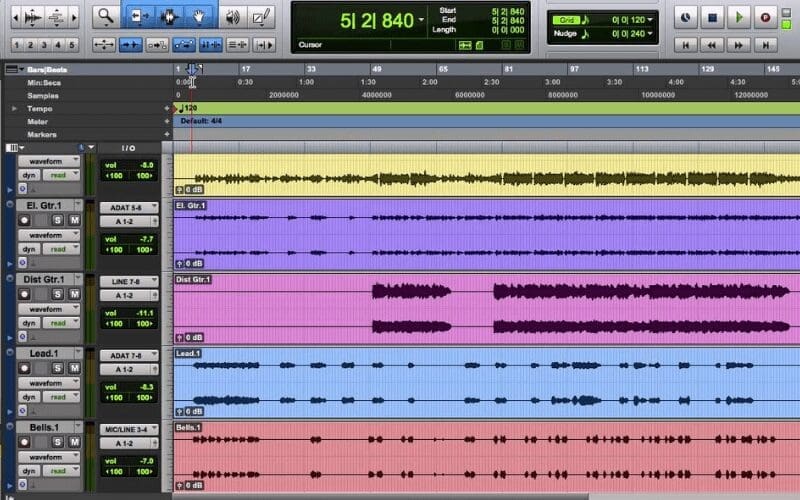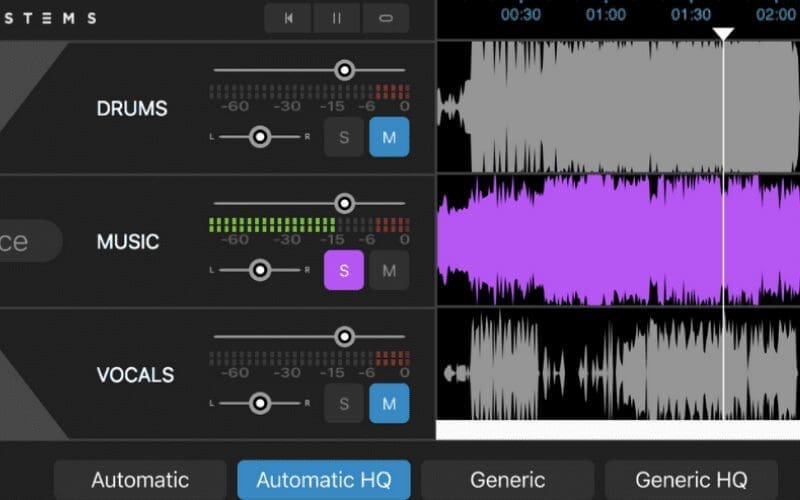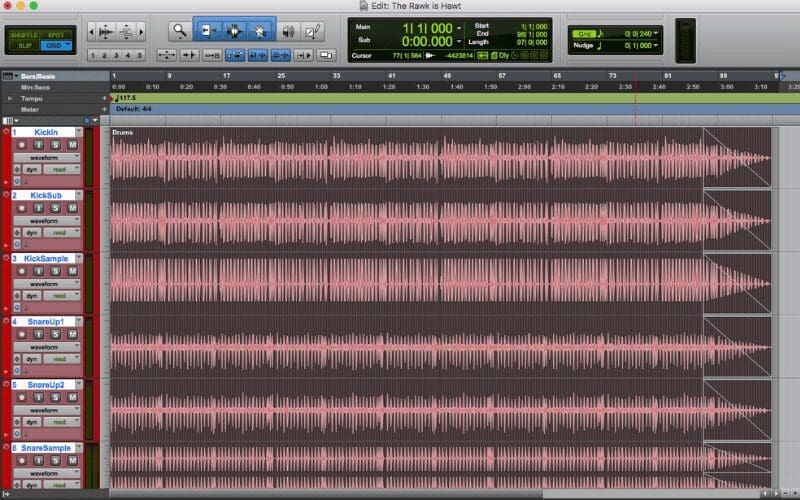If you’re already producing like a pro, then you’ve probably already heard of stems. Maybe you have been using them in software for a while. But what’s the difference between stems and tracks? Could you define what is a stem in music production?

This article should make the world of stems a little clearer, as well as explaining what the benefits of stems are, how to export stems and how to get music stems online.
Stems are incredibly useful in audio production, giving producers way more flexibility in the editing and creative process. So, let’s get started!
What Are Stems In Music Production?

Essentially, they are fragments of a whole piece. They package together individual tracks i.e. snare drum or an individual vocal track (if there are two/three-layered voices singing the same line) into useful categorised files to create a piece of music.
They are stereo recordings that mix multiple audio tracks and usually include the processing applied by mixing engineers (EQ, compression, time-based effects). It’s common for stem files to be grouped by musical instrument. For example stems often include drums, bass, guitar, vocals, and keys so groups of instruments.
Tracks or multiple tracks, by contrast, are mono or stereo recordings of individual elements. One of the three voices will be a track while ‘vocals’ (all three) will be a stem. Similarly, the bass drum and hi-hat would be tracks, while ‘drums’ (all drum kit recordings together) would be a stem.
Both multi-tracks and stems are audio files but they’re not interchangeable. Crucially, tracks will not include any mixing effects found on stem files. Make sure that when asked for the tracks from a song while collaborating on music production, you clarify if it’s the stems of the song or the tracks that are needed. Don’t assume your colleague is clear on the difference and end up doing three times the work for no reason!
The Benefits Of Music Stems
With all that said, why group tracks into stems at all? Why are they so useful?
Efficiency For Mixing

As you’d expect from our drums example, in a recording with a large ensemble or several parts, using tracks can get messy.
There will always be more tracks than stems so working with stem files will usually be easier and faster. This goes for you as a producer working with the files, as well as for anyone you’re collaborating with.
Sending stacks of tracks between one another can get disorganised and confusing to work with. Stems neatly package key components of the music together – great for sharing, great for editing.
How does this work in practice? Overdubbing with stems (fewer files) is going to be more efficient and less hassle.
What about collabs? Let’s say you need a violin solo recorded by an artist in Quebec. Sending over the files will still allow the violinist to turn up the keys and turn down the other competing string parts.
In cases like this, your violinist isn’t going to need every individual recorded file because they aren’t editing or mixing. 40 odd tracks might even fry their (non-music production-friendly) computer.
Repurpose Tracks Easily

Let’s say an EDM song “Bad Kevin’s Cheeky Mix” ends up racking up the downloads. The artist is approached by brands asking to use the song in their commercial but with a little less of the drums and bass, and a little more of that saxophone melody.
With stem tracks (drums, bass, guitars, saxophone) that would be easily done. Without stem files, that editing process would be a heck of a lot longer and Kevin might miss out on the opportunity to expand his reach and increase his royalties.
The same goes for any remixes. DJs, beatmakers, and producers will frequently take distinctive elements of the song and switch up the tempo, loop a melody or switch out the percussion for something new.
If the original artist sends over stem files, the remixer doesn’t have to mix, cut, and chop the tracks themselves, but simply load up the stems of a song into their remix software for easy editing.
Stems – Useful For Mastering

Mixing engineers are responsible for adjusting the individual tracks, not the mastering engineer.
At the mastering stage, engineers are usually working with the final stereo mix. For some specialist tweaking, mastering might require access to the multi tracks too.
More often it’ll be stems that will help the engineer achieve that beautiful finish, adjusting levels, making the drums a little punchier, or bringing warmth to the vocals.
Don’t forget, with our incredible free Music Distribution service here at Мusic Gateway, we master your music for free to make sure that you sound the best you can before your release.
We also offer a free Mastering Tool where you get instant online mastering – free. Forever.
Check it out today!
How To Export Stems From Your DAW

We’ve seen how useful stems can be in your DAW (Digital Audio Workstation) but what happens when the mix is done, and your baby is ready to be heard? How do you get the mix out of your DAW and into the world for your fans to enjoy?
You’ll want to export (or bounce) your files out from the DAW into your hard drive. Generally, this will mean writing the final mix into a stereo audio file. But if you want to retain the stem music files it’ll require printing stems of all instruments in the mix.Here are some quick steps for exporting stem music files from Logic Pro X, Ableton Live, Pro Tools, or FL Studio:
- Open the Bounce/Export dialogue box in your DAW
- Select export range/bounce source/export file destination and fill in details
- Ensure your mastering settings are right (i.e. the export is set to generate stereo files)
- If appropriate choose your export speed – real-time or offline
- Bounce!
Regardless Of Your DAW
Don’t export to a lower resolution than what your project currently uses.
If your DAW has the option to create WAV or AIFF files, these are lossless formats that work great for mastering. Retaining these formats for your export/bouncing is a good idea.
Additionally, don’t normalise (this increases the gain of your file leaving even less room for mastering). Select interleaved to generate a stereo export file (multiple mono is only relevant for individual tracks).
Furthermore, real-time bounce refers to writing the audio file to disk at the speed of playback in the DAW. This often means a slower, but perhaps more reliable, export speed. Offline bounce is much faster but given that files will be packaged as stems, this is less crucial than when exporting many tracks.
How To Get Music Stems

If you are a content creator that uses royalty-free music sites, you’ll have spotted stems before. Epidemic Sound and Soundstripe, for example, both allow their members access to stem files for any tracks they download.
On these sites, the original artists have provided users with the stem files so they can manipulate levels, remove parts, or remix tracks however they like for their commercial or personal purposes.
There are also other sites providing access to stems. Online communities like Splice.com, Wavo and Skio have regular remixing competitions that challenge music producers to remix popular rock, EDM, rap, and reggaeton tunes.
In these competitions, popular tracks’ stem files will be released to competitors. This is a great way to have access to stems of a contemporary, chart quality song.
How else can you get them? If you’re willing and able to pay, Traxsource offers a large catalogue of EDM stems on behalf of artists and record labels. If you’re feeling brave, reaching out to record labels directly can be one of the best ways to source very high-quality stems for popular songs.
Ideally, the remix will be of a very high standard too, in which case the label may even release rights for an official remix. Labels are not always receptive to remixes, but it might be worth a try if you can’t access the stems anywhere else.
Our Final Thoughts – Stems

So that’s our article on creating stems in music production!
You’ve read about what music stems are and how to differentiate between stems and tracks. We explained what uses there are for stem making musical instruments files and why they can really benefit mixing engineers, producers, and mastering engineers. We also unpacked how you can export these files from your own music software to generate stereo files on your laptop.
Finally, we looked at how you might find these files elsewhere; from royalty-free music sites and remix competitions to paid catalogues and record labels themselves. Hopefully, you learned something new that you can use in your own music production or remixing.
We hope that you found this guide useful! Don’t forget to share it across your socials and give us a tag @musicgateway! Also, whilst you’re here, why not check out some more of our helpful guides? Such as Reverb In Music Production & Mixing Explained or What Is The Best Laptop For Music Production?
What is a Driftmaker VST? Click here to find out more.










